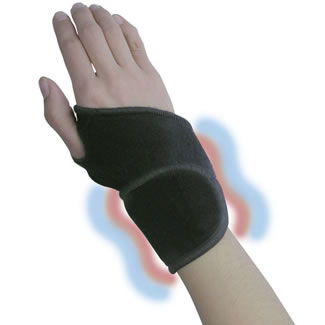Hot Application
 Hot applications, or applying small amounts of heat to an area which is sore, can also be beneficial for pain that is not in the inflammatory stage. If your hand is sore from injury or overuse, hot applications can be very helpful. Typically hot application is achieved by soaking the injured hand in warm water at a temperature that is hot enough to make a difference, but not hot enough to harm you. Other applications include wrapping a warm, wet towel comfortably around the hand. The heat and the compression can work together to ease the achiness or soreness. Hot applications can also be applied in conjunction with cold applications. Alternate between hot and cold by creating a hot/cold bath for your hand. This is as simple as it sounds; soak the hand in ice water for a few minutes and then place it in warm water for a few minutes. The duration and alternation between the hot and cold temperatures is completely up to you and what you feel is comfortable, but, with that being said, it is not recommended to leave your hand in either extreme for more than 5 minutes at a time. If this process creates more pain than usual, stop immediately and discontinue the process. Hot applications should always be applied gradually to ensure that no further damage occurs to the area.
Hot applications, or applying small amounts of heat to an area which is sore, can also be beneficial for pain that is not in the inflammatory stage. If your hand is sore from injury or overuse, hot applications can be very helpful. Typically hot application is achieved by soaking the injured hand in warm water at a temperature that is hot enough to make a difference, but not hot enough to harm you. Other applications include wrapping a warm, wet towel comfortably around the hand. The heat and the compression can work together to ease the achiness or soreness. Hot applications can also be applied in conjunction with cold applications. Alternate between hot and cold by creating a hot/cold bath for your hand. This is as simple as it sounds; soak the hand in ice water for a few minutes and then place it in warm water for a few minutes. The duration and alternation between the hot and cold temperatures is completely up to you and what you feel is comfortable, but, with that being said, it is not recommended to leave your hand in either extreme for more than 5 minutes at a time. If this process creates more pain than usual, stop immediately and discontinue the process. Hot applications should always be applied gradually to ensure that no further damage occurs to the area.
REFERENCES:
- Flusser D, Abu-Shakra M, Friger M, Codish S, Sukenik S (2002) Therapy with mud compresses for knee osteoarthritis: comparison of natural mud preparation with mineral-depleted mud. J Clin Rheumatol 8:197–203
- Akhtar, N.; Haqqi, T. M. Current Nutraceuticals in the Management of Osteoarthritis: A Review, 2012.
- Therapeutic Advances in Musculoskeletal Disease 4 (3): 181–207
- Medications to Treat Hands and Wrists, Arthritis Foundation, 2010
- 14 foods that fight inflammation. www.health.com, 2015.
- Holmes L, 5 Delicious, real foods that reduce inflammation, MindBodyGreen, Feb, 2015.
- Hyman, M. Ultra-metabolism: The Simple Plan for Automatic Weight Loss. New York, New York: 2006, P137
- Long K. The Journal of Nutrition, October 2006; 136:2600-2605.

